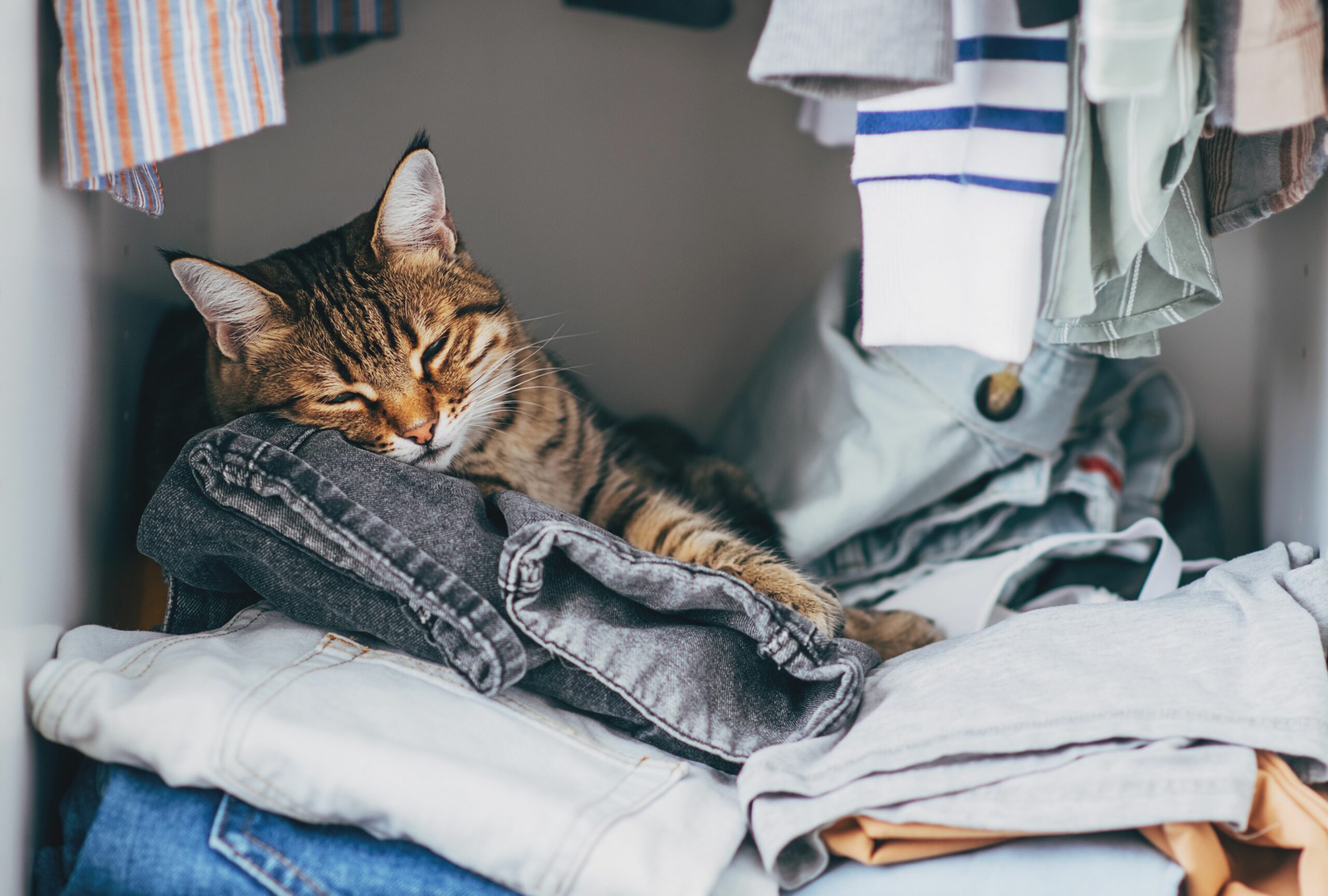As pet parents know all too well, keeping fur at bay, especially if your pet is a high-shed breed or a seasonal shedder, requires a holistic approach. A combination of strategies, including regularly grooming and staying on top of vacuuming floors, furniture, and your pet’s bedding, can help to cut down on the presence of hair in your home, and on launderable items.
Of course, come wash day, even the most diligent pet groomer and housekeeper will find fur on clothes, sheets, towels, and more. Fortunately, there are several ways to get pet hair out of laundry that don’t require a ton of extra work on your part. Read on for our best tips for washing fur-covered clothes, as well as products that help trap hair, leaving your clothes and other items clean and fur-free.
1. Shake Fabric Before Washing
One of the easiest ways to dislodge loose pet hair is simply to shake the items out prior to loading the washing machine. Of course, doing so will leave hair all over your laundry room, so it may work best for those who have an easily accessible outdoor space. If you do shake out fur-covered clothes and linens indoors, use a rubber broom or a vacuum designed for pet hair to keep your room free of excess fur.
2. Use the ‘Dry, Wash, and Dry’ Method
Wash day has a predictable rhythm: Put laundry in the washer, then transfer laundry to the dryer, line, or rack to dry. But upending this routine can be the ticket to successfully eliminating pet hair. Instead of putting laundry directly into the washer, place the load in the dryer first. Starting with a short no-heat tumble dry cycle can help to loosen pet hair, which the dryer’s lint screen will trap for easy disposal.
3. Try a Hair-Removing Roller
Before loading fur-covered items into the washer, use a hair-removing roller to pick up loose hair. We especially like the ChomChom Pet Hair Remover, which uses an electrostatic charge to attract pet hair, quickly lifting it off fabrics. This inexpensive pet hair remover is also reusable, making it a cost-effective alternative to traditional sticky rollers. However, for those who prefer sticky rollers with tear-off disposable sheets, look for extra-sticky rollers, such as Evercare PetLovers Extra Sticky Lint Roller, or oversized rollers, like Scotch-Brite 50% Stickier Large Surface Lint Roller, which can make quick work of removing fur from larger items like comforters, duvet covers, and blankets.
4. Use the Rubber Glove Trick
Products made from rubber, including brooms and grooming tools, are commonly used for cleaning up pet hair because rubber dislodges and traps fur on hard and soft surfaces. Running a rubber glove over fabrics covered in pet hair has a similar effect, quickly picking up loose hair from clothing and other textiles. Try stashing a pair of rubber gloves by your hamper or the washing machine for easy access, and use them to give furry clothes a quick swipe before they go in the washer. This is also a good way to upcycle a pair of rubber gloves that may no longer be serviceable for cleaning jobs because they have a small hole or puncture.
5. Pick Up Fur with Damp Microfiber
Microfiber cloths have loads of uses, including picking up loose pet hair from fabric. It works best when the microfiber is damp, so start by wetting a microfiber cloth and wringing it out well so that it’s not dripping. Then, wipe the fur-covered fabric, working in a straight line from top to bottom, discarding fur as you work, and rinsing and wringing out the cloth as necessary.
6. Try an In-Wash Hair Catcher
Hair catchers designed for use in the washing machine, such as FurZapper or FurBall, can help to reduce the presence of pet hair on clothes, sheets, and towels. These products work by circulating with your laundry, grabbing onto pet hair to dislodge it from the fabric. For the best results, do not overstuff the drum so that the hair catcher has room to move, and avoid using them with fabric softeners, which can reduce their effectiveness.
7. Use Fabric Softener
Liquid fabric softener and dryer sheets can help to remove pet hair in the washer and the dryer, respectively. Fabric softeners are formulated to reduce static cling, and can help loosen pet hair from clothing and other items. However, liquid fabric softener and dryer sheets should not be used with certain fabrics, such as terry cloth, fleece, or performance gear with stretch or moisture-wicking elements.
Distilled white vinegar is a popular fabric softener alternative that can be used on most fabrics to loosen and dislodge pet hair. However, experts caution against overuse of vinegar in the washer because prolonged or repeated exposure can cause rubber parts like gaskets and hoses to disintegrate.
8. Give Dryer Balls a Whirl
Dryer balls are an alternative to liquid fabric softener and dryer sheets, helping dry laundry faster by increasing air circulation in the drum, which also reduces static. Wool dryer balls are particularly effective at capturing fur by creating an electrostatic charge that attracts and traps pet hair. Spraying wool dryer balls with water before placing them in the dryer cycle can help boost their fur-capturing abilities. To keep wool dryer balls clean, use a toothbrush to gently brush away any fur that has collected on the surface.
9. Employ Pre-Wash, Heavy-Duty, High Spin, and/or Extra Rinse Cycles
Making use of your washer’s specialty settings can help eliminate pet hair on clothing and household goods. The pre-wash setting will loosen pet hair, removing it from fabric before the wash cycle begins. Heavy-duty and high spin speed cycles can also help dislodge fur from fabric, and using the extra rinse cycle ensures that fur is completely washed away. Before using any of these settings, consult the care tag to make sure these cycles won’t damage the fabric.
10. Clean Machines Regularly
Keeping your washer and dryer clean and in good working condition is especially important for households with pets that shed. Pet hair builds up quickly, clogging filters and reducing the effectiveness of these wash-day appliances.
Most washing machines have a filter that traps hair, lint, and other debris. It is important clean the washing machine’s filter to ensure that pet hair does not build up; in homes with high-shed or seasonal shedding animals, aim to clean the washer filter once a month.
Dryers, too, must be cleaned regularly to ensure they work properly and safely. The lint screen should be cleaned after every use to reduce the amount of debris that passes into it. In addition, it’s important to deep clean your dryer’s vent regularly to ensure peak performance and to prevent a dryer fire. Dryer vents should be cleaned at least once a year, but households with pets should increase the frequency of vent cleaning to two to four times a year. Signs that a dryer vent needs to be cleaned include a burning smell while operating, the unit becoming hot to the touch, the laundry coming out hotter than usual, or the laundry taking longer to dry than usual.


